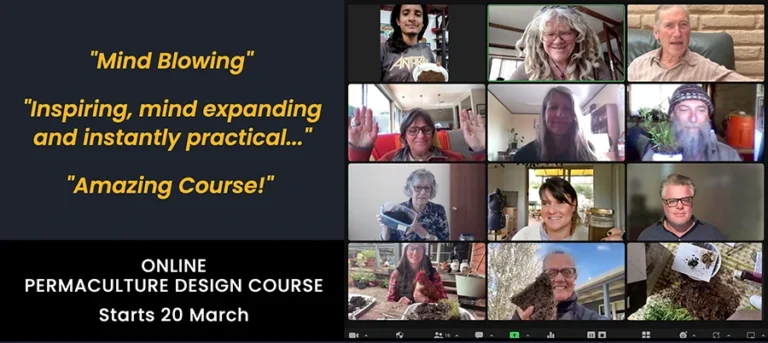
After conversations with David Holmgren, Rob Hopkins, co-originator of the Transition Network, put together some thoughts about how to apply the permaculture design principles in business.
Business, Resilience and Transition
“In many ways business is already ahead of the rest of us in terms of some of the thinking approaches that are required for energy descent. They are used to thinking ‘lean’ and getting the most out of things. The shift will be from merely prioritising output to thinking more widely. These principles offer a good lens through which to look at how to build resilience for business.” From Rob Hopkin’s original post.
![]() The power of good observation is something not many of us have, and detailed observation of where we are will underpin any actions we undertake. A post-peak world will depend on detailed observation and good design rather than energy-intensive solutions.
The power of good observation is something not many of us have, and detailed observation of where we are will underpin any actions we undertake. A post-peak world will depend on detailed observation and good design rather than energy-intensive solutions.
This principle challenges the idea that you only take your information from accredited sources and from sources within the industry itself, ie. secondary data that someone else has processed. In these times, businesses will need to learn to look out of the window, to, as it were, not rely on weather forecasts but to learn to read the clouds, to ask awkward questions whereas before they just accepted the information provided.
Paul Hawken put it thus; “instead of researching the market, be the market”. If you see a need for information or for a product, it is likely that someone else, somewhere else, is seeing the same need. Rather than relying on information gathered at arms length, businesses should be out there observing. This has always much more been something SMEs excel at, but larger businesses tend to rely more on surveys and on second-hand information. Having a feedback relationship with one’s customers, with the people who are actually using the product, is very important, direct contact with customers.
![]() Energy passes through our natural systems, and is stored in a variety of ways, in water, trees, plants, soils, seeds and so on. We need to become skilled at making best use of these, and move our idea of ‘capital’ from what we have in the bank, to the resources we have around us. I once heard Holmgren say that a good woodpile, such as you would see in Eastern Europe, is a far more reasonable indicator of national wealth than GDP.
Energy passes through our natural systems, and is stored in a variety of ways, in water, trees, plants, soils, seeds and so on. We need to become skilled at making best use of these, and move our idea of ‘capital’ from what we have in the bank, to the resources we have around us. I once heard Holmgren say that a good woodpile, such as you would see in Eastern Europe, is a far more reasonable indicator of national wealth than GDP.
This principle stresses the importance of not running a business on a constant high speed cash throughput with little or no capital reserves. It highlights the perilous lack of resilience in the just-in-time supply approach. It advocates a shift to storages of parts and materials, as well as the need to financially not be so dependent on debt financing. A preferable approach would be to work slower with more financial reserves and take less risks, not building beyond what the company’s financial resources can support.
The principle is either to not borrow any money at all, or to borrow so much money that you can’t fail, being bigger than the people you borrow money from, so they have a vested interest in your succeeding! This principle also stresses the need to make a business’s buildings as energy efficient as possible, and as able to trap, store and make use of the sun and other energy that is ‘passing through’ the site. When seen just in the short term, making buildings and operations more energy efficient is not seen as a sensible investment, but the thinking needs to become more long term. The payback for such things is not merely financial, it is in the form of resilience and insurance, it is measured in the long term. Looking to make buildings as autonomous as possible in a world entering energy descent is critical.
This principle also stresses the need to see things that are flowing past and through the business that others don’t see as being a resource and having no monetary value as being valuable.
![]() This principle states that any intervention we make in a system, any changes we make or elements we introduce ought to be productive, e.g. productive trees in public places, edible roof gardens, or urban edible landscaping.
This principle states that any intervention we make in a system, any changes we make or elements we introduce ought to be productive, e.g. productive trees in public places, edible roof gardens, or urban edible landscaping.
This is something that businesses do intuitively, when thinking about maximising cash flow, about doing something that someone needs in order to be able to sell it. This is instinctive to businesses. However, many of us with no business experience have forgotten this. Also, much of business, especially at a corporate level, have taken this to extremes that are exploitative, distorting and damaging, seeing profit maximisation at the sole focus. Obtain a Yield, in this context, is out of balance.
If Catch and Store Energy is about maximising capital, Obtain a Yield is about income, and the observation that our businesses, our projects, need to generate a profit.
![]() A well-designed system using permaculture principles should be able to self-regulate, and require the minimum of intervention and maintenance, like a woodland ecosystem, which requires no weeding, fertiliser or pest control.
A well-designed system using permaculture principles should be able to self-regulate, and require the minimum of intervention and maintenance, like a woodland ecosystem, which requires no weeding, fertiliser or pest control.
This principle recommends moving from “we’re just obeying the law” to being proactive, acting before you get hit over the head with regulation and other vulnerabilities. Businesses need to be able to put a foot on the break, not just going hell for leather on profit maximisation. We need to be able to apply applied restraint, avoiding excessive, overfast growth that hasn’t been consolidated. There is the danger of economic ‘bubbles’, even in the world of renewable energy, if people throw all their money into it but it isn’t consolidated.
This principle is about looking for the negative feedbacks, from customers and from the environment in general. It is key to build these negative feedbacks in in order to stay ahead of the game. We need to increase the tightness of feedbacks.
![]() Where nature can perform particular functions, be it aerating soil (worms), fixing nitrogen (clover) or building soil (trees) we should utilise these attributes, rather than thinking we can replace them. Where nature can take some work off our hands we should let it.
Where nature can perform particular functions, be it aerating soil (worms), fixing nitrogen (clover) or building soil (trees) we should utilise these attributes, rather than thinking we can replace them. Where nature can take some work off our hands we should let it.
This principle recognises the need for a general shift away from a dependence on non-renewable energy sources, both directly as fuels and indirectly as embodied fossil fuel use. It encourages the valuing of these resources. It also emphasises a shift towards renewable resources. For example, current thinking is that we should value a forest by not using it, but ‘conserving’ it. Instead we use plastic instead of wood. When we look at renewable resources, we need to look at their husbandry, as stocks of renewable resources are smaller and have quicker feedback loops than their non-renewable counterparts. In this context it is useful to ask, “are this business’s inputs being sustainably managed?”.
As a business shifts more and more towards smaller and smaller resources, you will need to deal with issues of renewability. The emerging opportunities for businesses are things that are renewable. Renewable energy sources are the ones that will ensure a business’s stability in the long run. We can also broaden the concept of renewable resources to include things like goodwill and trust, things which a business can rebuild with good husbandry. Most business doesn’t just depend on law and competition, trust is at the heart of much business and it is very much a renewable resource.
![]() The concept of waste is essentially a reflection of poor design. Every output from one system could become the input to another system. We need to think cyclically rather than in linear systems.
The concept of waste is essentially a reflection of poor design. Every output from one system could become the input to another system. We need to think cyclically rather than in linear systems.
This is well explored elsewhere, i.e. in William McDonagh’s Cradle to Grave approaches, and their concept of Waste = Food. It emphasises the concept of closing loops wherever possible.
![]() We need to be able to keep looking at our work from a range of perspectives. This principle argues that we need to see our work in the wider context of watershed, regional economy and so on, so as to keep a clearer sense of the wider canvas on which we are painting, and the forces that affect what we are doing.
We need to be able to keep looking at our work from a range of perspectives. This principle argues that we need to see our work in the wider context of watershed, regional economy and so on, so as to keep a clearer sense of the wider canvas on which we are painting, and the forces that affect what we are doing.
There is a lot to be gained from stepping back and seeing the bigger picture. While it is important to focus on getting the details right, being strategic is important too. Many large businesses do have teams that do strategic thinking, but it is a luxury that few smaller businesses have. It is important to ask how is what we are doing part of a bigger picture, the move away from globalisation and towards the local, taking steps back from the everyday.
This can be done firstly by allowing space for Devil’s advocates, for black sheep, for hearing the voices of those outside of the dominant culture of the organisation and secondly by looking from a holistic perspective of how things interconnect, rather than just relying on experts who are embedded in detail. It emphasises the need to value the generalist, to give value to holistic thinkers.
This is also where scenario planning comes in useful, allowing people to imagine different possibilities.
![]() Permaculture has been described as the science of maximising beneficial relationships. In a powered-down settlement, what will become increasingly important is the relationships that we can weave between different elements of the place. Solutions are to be found in integrated holistic solutions rather than increased specialisation and compartmentalisation. The challenge here is to move to seeing business as being part of the geographical community, as being rooted in place, rather than just part of a globalised community. At the moment for many larger businesses, the local is something one pays lip-service to as a source of good PR, something one is passing through, rather than actually being an integral part of the community.
Permaculture has been described as the science of maximising beneficial relationships. In a powered-down settlement, what will become increasingly important is the relationships that we can weave between different elements of the place. Solutions are to be found in integrated holistic solutions rather than increased specialisation and compartmentalisation. The challenge here is to move to seeing business as being part of the geographical community, as being rooted in place, rather than just part of a globalised community. At the moment for many larger businesses, the local is something one pays lip-service to as a source of good PR, something one is passing through, rather than actually being an integral part of the community.
This is a profound structural challenge for large organisations. Part of the resilience of the organisation comes from the degree of lateral integration. Resilience is in all solutions, it is the characteristic of ecological systems. If we apply these principles, resilience is one of the emergent properties.
![]() At the moment, economies of scale always encourage businesses to think bigger and bigger. While it is important to note that small is not always best, the notion that big is best needs to be challenged. In this new energy world, never assume that the big will replace the small. In practice what happens in business is that the big fish do eat the fish just below them, but as they grow, a number of new opportunities open up at smaller scales.
At the moment, economies of scale always encourage businesses to think bigger and bigger. While it is important to note that small is not always best, the notion that big is best needs to be challenged. In this new energy world, never assume that the big will replace the small. In practice what happens in business is that the big fish do eat the fish just below them, but as they grow, a number of new opportunities open up at smaller scales.
For example, in aviation it might look as though we now only have a few operators, but on smaller routes there are now many smaller companies with smaller overheads running those routes. We are seeing this too in the increase in small bakeries and breweries. These new opportunities are very hard to understand and exploit from a macro level perspective, and are much better done from small scale perspective. It is here that the idea of appropriateness of scale becomes key.
This is also where scenario planning comes in useful, allowing people to imagine different possibilities.
![]() Monocultures are incredibly fragile and prone to disease and pests, more diverse systems have much more inbuilt resilience. Our towns will be much more able to prosper during energy descent if they have a diversity of small businesses, local currencies, food sources, energy sources and so on than if they are just dependent on centralised systems, globalisation’s version of monoculture.
Monocultures are incredibly fragile and prone to disease and pests, more diverse systems have much more inbuilt resilience. Our towns will be much more able to prosper during energy descent if they have a diversity of small businesses, local currencies, food sources, energy sources and so on than if they are just dependent on centralised systems, globalisation’s version of monoculture.
This refers to the diversity between different systems, and how during Transition, the idea that everything will continue to be best served by business approaches which dismantle diversity will become inappropriate. Internally within the business this principle is about insurance, about not having all your eggs in one basket. It is key that the business identify its key input sources such as energy supplies, and seek to diverse the base from which it obtains them.
In the short term this kind of diversification could reduce profits, but in the longer term it will be more secure. Traditionally, the agricultural sector suffered from a high degree of uncertainty, being one storm or famine away from great hardship, whereas manufacturing and the rest of society were further away from it, better insulated. Now the level of uncertainty facing farmers is shared more and more businesses as their oil vulnerability becomes more problematic. In essence, this is about the reverse of specialisation, about having a mixed portfolio, and presents a big culture change for businesses.
In the same way that wild food is not something we depend on but which in tough times we need to understand and have access to in order to survive, it is a good strategy for business to keep a diverse portfolio of what sustains the business, keep some things that appear to be peripheral. They may not at this stage appear to be a serious part of how the business is run, but in this new world they will increasingly become so. For example, if the business were to transform its surrounding landscape into a productive urban landscape, it would offer some degree of food security, the workers could buy some food, and it may actually turn out to be the reason they stay loyal and keep working for our business rather than going elsewhere, and could be the difference between whether or not we have a reliable and well-fed workforce!
![]() One of the observations used a lot in permaculture is the idea of ‘edge’, that the point where two ecosystems meet is often more productive than either of those systems on their own. This principle reminds us of the need to overlap systems where possible so as to maximise their potential.
One of the observations used a lot in permaculture is the idea of ‘edge’, that the point where two ecosystems meet is often more productive than either of those systems on their own. This principle reminds us of the need to overlap systems where possible so as to maximise their potential.
This principle is about recognising that innovation doesn’t come from the centre but from fringe thinkers. New business entrepreneurship comes from places with cheap rent, that tend to be cheap to rent, a bit tatty, loose and unregulated. It comes from the wild side, not from Governments or corporations. This principle is about giving status to the marginal. It is important that the business has as many fingers in as many pies as possible, as many interfaces, and recognises that every person working for the business represents it in the community.
![]() Natural systems are constantly in flux, evolving and growing. The way they respond to shock, such as forest fires, can teach us a great deal about how we might manage the transition away from fossil fuels. Remaining observant of the changes around you, and not fixing onto the idea that anything around you is fixed or permanent will help too.
Natural systems are constantly in flux, evolving and growing. The way they respond to shock, such as forest fires, can teach us a great deal about how we might manage the transition away from fossil fuels. Remaining observant of the changes around you, and not fixing onto the idea that anything around you is fixed or permanent will help too.
The business sector has generally learnt to be quite good at this. Forces come out of the blue that businesses have to respond to, and they have learnt to be flexible, lean and adaptable. Business culture has a lot of strengths here, it has learnt not to be squeamish about change, to be able to ditch things it had previously thought of as essential. Now, as we enter energy descent, it will have different criteria than in the past.
A healthy approach is to start with no complete plan, to allow the process to be emergent. This is not a time when we can work to a rigid plan as conditions will change so fast. Organisations will need to stay on their toes, without rigid management.



